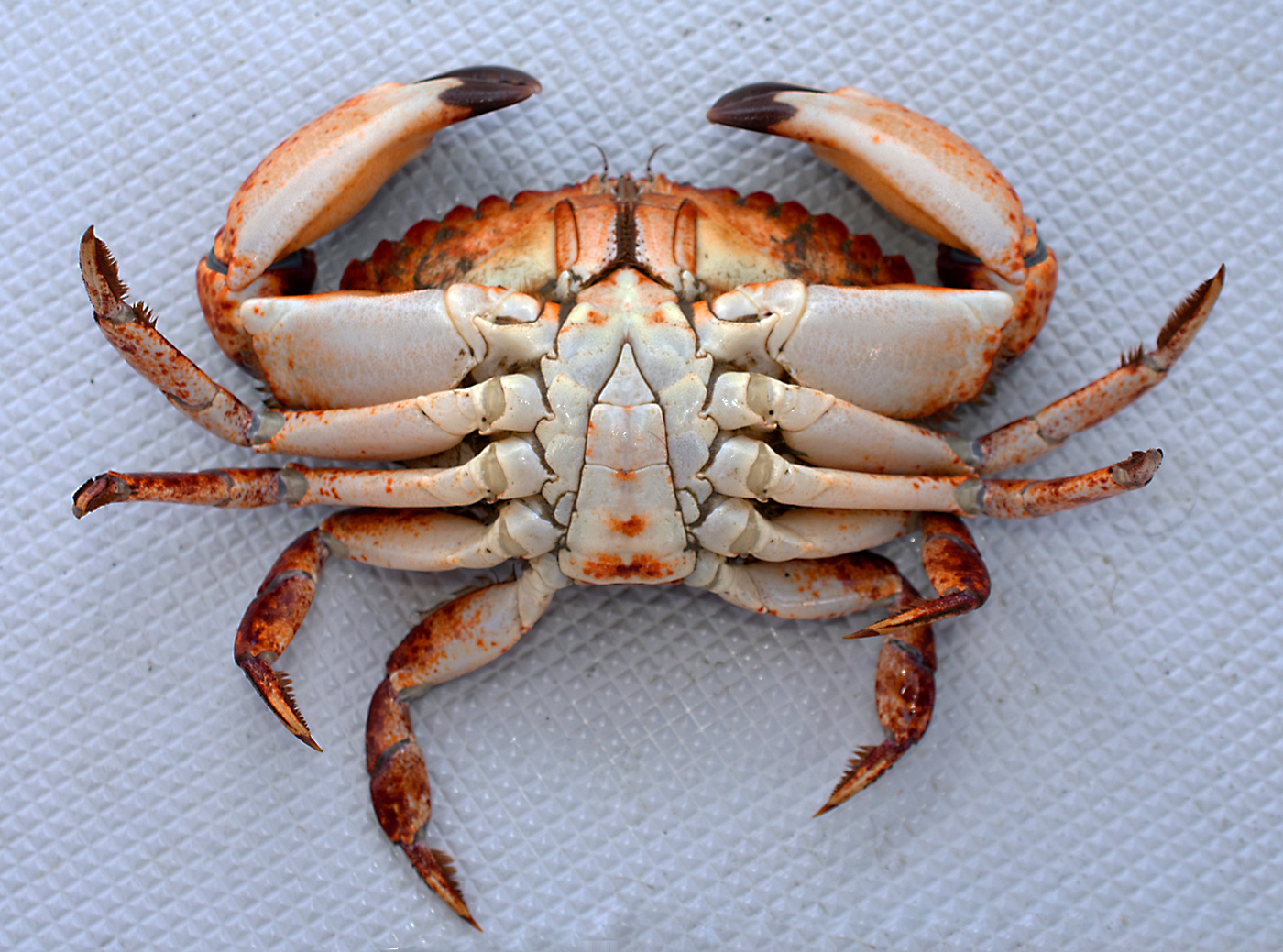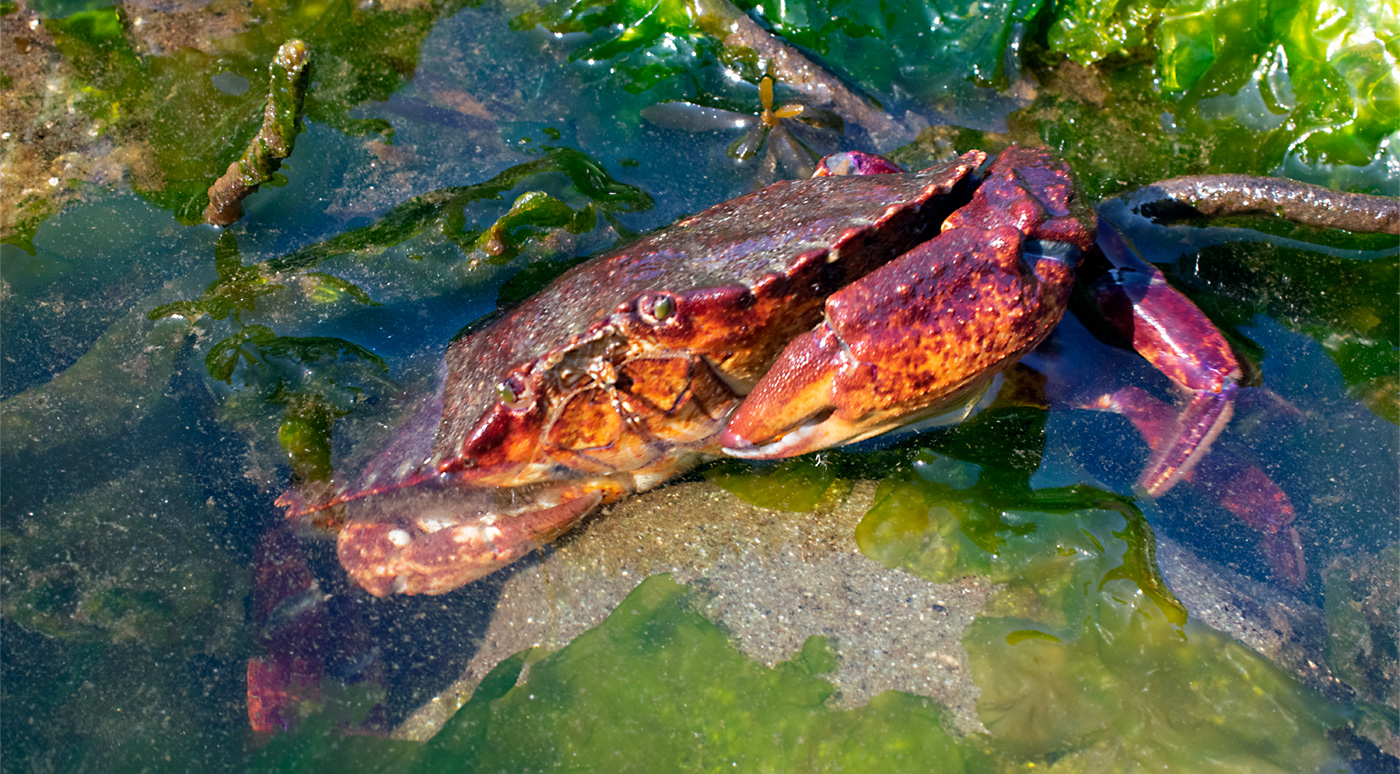Red Rock Crab
Author: Jhadel Lewis
Scientific name: Cancer productus
Size range: Males up to 200mm (7.8in), Females up to 168mm (6.6in)
Identifying Features: These types of crabs are usually medium sized, with adults varying anywhere between 100-200mm wide. They typically have shells that are broad and hard, and reddish-brown in colour, which causes them to be easily identifiable in the intertidal zones. They also have distinct black tipped piners to help identify them from other species, in addition to asymmetrical claws in which the larger one (“crusher claw”) is used to break open shells.


The juvenile Red Rock Crabs appear different compared to the adults. Aside from being much smaller than the fully matured ones, they have a significant colour variation, with most appearing white or red with white stripes. Juveniles also have softer shells than adults. Because of this, they normally stay shrouded in rocky crevices or detritus for protection/shelter.
Habitat: Red Rock crabs are known to inhabit along the Pacific coast, including the waters surrounding Victoria, BC. They spend a lot of their time in the intertidal zones – a region home to many hiding locations such as numerous rocky areas, kelp beds, and eelgrass meadows. Despite them being able to live at a depth up to 79 metres, they are more commonly found in the more shallow parts of the waters, particularly sheltered bays so they can feed and circumvent strong currents.
Food (Prey): Red Rock Crabs are diverse feeders with a very flexible diet. Their main source of food comes in the form of molluscs like clams and snails. Their antennae are full of chemoreceptors, which gives them the ability to notice chemical signals in water. These chemoreceptors help crabs to sense possible food sources and they capture the food using their “crusher” claw to break open shells whilst the smaller claw is used for handling small fishes, etc.
Predators : Aside from humans, Red Rock Crabs are constantly preyed upon by sea otters, octopuses, and larger fishes like the lingcod. They often rely on the hardness of their shells, mobility, and camouflage to protect themselves from being eaten. If necessary, they also have the ability to shed a claw when grabbed by a predator, and the lost limb will be replaced by a new one that the crab regenerates.
Life Cycle : The Red Rock Crab’s life cycle starts when a female lays fertilized eggs that are stored beneath its abdomen. Tens of thousands of eggs can be produced during this period. The eggs will then hatch into planktonic larvae after a couple of weeks and drift freely in the water with the aid of ocean currents. The larvae would then be subjected to a number of developmental stages known as “zoeal stages”, in which they consume plankton and experience multiple moults. They will then enter the last stage of development (megalopa stage) after several more weeks before they ultimately settle as juvenile crabs on the sea bed. The juvenile Red Rock Crabs carry on with their maturation and undergo moulting periodically to develop harder shells. This process could take as long as two years before they finally enter adulthood. Adults may still continue to shed their shells occasionally, although not as often as they get older and propagate.
Fun Facts :
- They have the ability to regenerate a limb that has been lost, which is a useful skill set that helps them survive from predators.
- They take up an important role in their aquatic ecosystem by regulating the populations of mollusks and other small invertebrates.
- They can live up to 10 years in the wild, however due to predation and environmental factors, most do not reach this age.
Photos by D. Young
References:
Online Citations:
Animal Spot. (n.d.). Red rock crab. Retrieved December 9, 2024, from
https://www.animalspot.net/red-rock-crab.html
Fish’n BC. (2018). Red rock crab. Fish’n BC. Retrieved December 9, 2024, from https://www.fishnbc.com/species/red_rock_crab.html#google_vignette
Island Nature. (2010, February 21). Red rock crabs. Island Nature. Retrieved December 9, 2024, from https://islandnature.ca/2010/02/red-rock-crabs/
Books:
Jensen, G. C. (1995). Pacific coast crabs and shrimps. Monterey, CA: Sea Challengers.
Harbo, R. M. (1999). Whelks to whales: Coastal marine life of the Pacific Northwest. Madeira Park, BC: Harbour Publishing.

